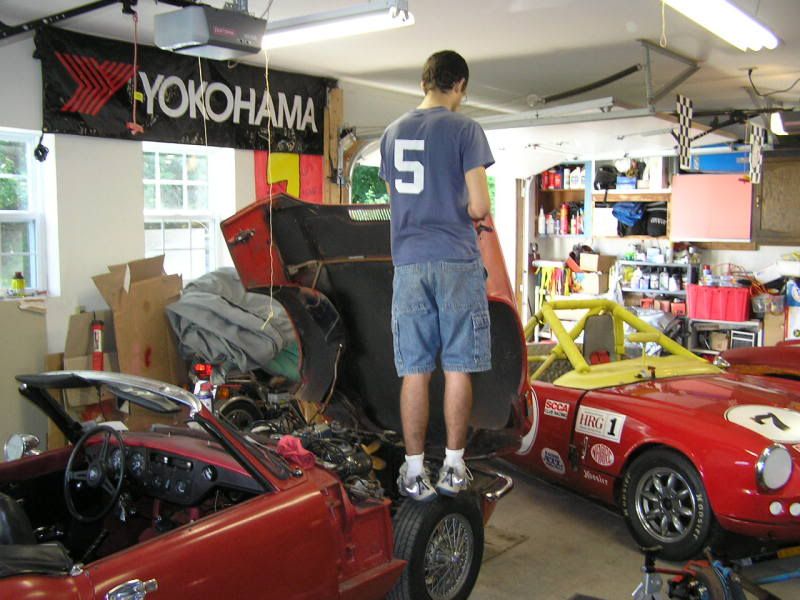[Editor's Note: This article originally appeared in the March 2015 issue of Classic Motorsports. Some information may have changed.]
The Triumph Spitfire is an enthusiast’s dream: beautiful Italian lines, perfect driving position and tremendous aftermarket support. Group 44 Inc. and others made the Spitfire a winner on track.
Spitfire fans know the truth: This is a revolutionary machine. Look back at 1962, the year of its debut. While other sports cars were still relying upon side curtains and solid rear axles, the Spitfire sported windup windows, independent rear suspension and front disc brakes.
What hurt the Spitfire? Some bad press. The early cars were dinged because their swing axle rear suspension could allow the inside tire to tuck underneath. Fortunately a camber compensator solved that issue. It’s an easy aftermarket bolt-on that eventually became standard equipment.
Spitfire production lasted all the way until 1980–the end of the era for British sports cars– and Triumph made plenty of changes along the way. The original Spitfire received a 1147cc engine that produced 63 horsepower, and for 1967 displacement increased to 1296cc.
Engine size didn’t increase for 1970, but the body received a facelift that year. Giovanni Michelotti freshened his original design, removing the seams found atop each front fender and squaring off the body’s rear end.
The next big change came for 1974. By now Triumph and MG were kissing cousins, and the Spitfire would receive the same 1496cc engine found in the MG Midget. Also like the Midget, black plastic bumpers were bolted to both ends of the body. In the Triumph’s case, though, they didn’t appear until 1979.
Despite all of the engine upgrades, emissions regulations always seemed to keep performance in check. The Spitfire never produced gigantic horsepower numbers–engine output was usually closer to 50 horsepower than even 100.
What the Spitfire delivered, both then and now, was open-air fun in a simple, pretty package that has always been within grasp of the average enthusiast.
Shopping Advice
Nigel Cosh owns a company called SpitBits, and they specialize in one thing: Triumph Spitfires.
Thrust washers are a common problem. Pull back and forth on the crank pulley to identify excess movement–0.006 inch is perfect.
Reverse gear teeth get damaged on the single-rail gearboxes (1975-’80) due to previous owners not engaging reverse correctly. This can end up costing quite a bit of money, as the lay gear can get damaged along with the first and second synchro gear. (Luckily, SpitBits had these parts remade.) Rust is probably one of the biggest problems on a Spitfire.
Rust in the front floor pans from water leakage around the brake and clutch master cylinder openings is very common, along with rust in the rockers. Rust in the bottom of the windshield frame on the Mk4 and 1500 cars can be very hard and expensive to repair.
Also check for sagging doors. A sagging door could be due to just worn hinge pins, but it also could indicate severe rot in the lower A-post/bulkhead.
Accident damage, especially on the front, can be a huge problem. Inspect the bonnet for damage and ensure that the gaps between the bonnet and doors/rocker panels are equal and aligned. Also check the bonnet- to-valance alignment. Remember to inspect the frame for damage or kinks, especially in front of the suspension towers. Look for uneven or excessive use of suspension adjusting shims.
Interiors generally rot pretty badly. Check the seats and seat tracks for operation and structural integrity by operating both the forward/aft movement and the recline mechanism. Early Spitfire seats are almost impossible to find in good condition, and seat tracks are getting harder to find for cars of any year.
Comments

Gary
HalfDork
3/16/15 1:49 p.m.
Best value of any vintage sports car that's out there.
'Read the rest of the story' link is 404
In reply to erohslc:
Yup. 
Looks like the link is fixed. I love my Spitfire and my Wife and sons love theirs too. It's a real family bonding experience, a great way to spend some time together.
(pushing the damn things into the garage so we can fix them again)

mike
You need to step over to the Classic site at classicmotorsports.com and click the link from there to view the story. Sorry, it's a bit of weirdness we are working to debug.
I love Spitfires but am unlikely to own one. They are a big reason why I run in the race group I do. I enjoy dicing with them and they also seem pretty sturdy with few DNFs........but with all that said I can't see me kicking my old Japanese car habit.
Tom
I've been looking for a vintage race car to run in the PIBRRR, and I've been concentrating on Spridgets. I don't know a ton about any of these older British sports cars. Is there a good reason to choose a Spitfire over a Spridget?

Marty
New Reader
3/18/15 8:08 a.m.
Well yes. All the cool people drive Triumphs! :)
In reply to Marty:
I didn't know that. But maybe you could go into a little more detail as to why that would be the case?
But maybe you could go into a little more detail as to why that would be the case?
They are very similar in size, weight, performance.
Each has their Achilles Heel.
Both are a ton of fun.
I'm a Spitfire guy because it was the first car I got involved with and raced.
Displaying 1-10 of 19 commentsView all comments on the CMS forums
You'll need to log in to post.






























